

Access the Applied Digital Skills Curriculum – Google Applied Digital Skills. Learning.blogs.nytimes. Video and a related lesson plan from TEDEd. Update: Please also see our new, 2017 lesson, Evaluating Sources in a ‘Post-Truth’ World: Ideas for Teaching and Learning About Fake News _________ How do you know if something you read is true? Why should you care? We pose these questions this week in honor of News Engagement Day on Oct. 6, and try to answer them with resources from The Times as well as from Edutopia, the Center for News Literacy, TEDEd and the NewseumEd. Lesson plan: How to teach your students about fake news. Fake news is making news, and it’s a problem. Not only did a BuzzFeed data analysis find that viral stories falsely claiming that the Pope endorsed Donald Trump and that Hillary Clinton sold weapons to terrorists receive more Facebook attention than the most popular news stories from established news outlets, but a false story about child trafficking in a Washington, D.C. pizza restaurant inspired a North Carolina man to drive 5 hours with a shotgun and other weapons to investigate.
This lesson gives students media literacy skills they need to navigate the media, including how to spot fake news. Subjects. K–12 Digital Citizenship Curriculum Scope & Sequence. How to Teach Students Historical Inquiry Through Media Literacy And Critical Thinking. “I think that the lessons of history are exactly the kind of thing we should be talking about in history class,” Wineburg said.
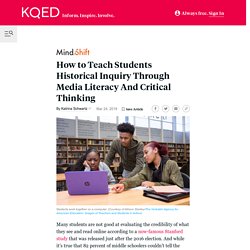
“But rather than teaching them as rules or things fixed in time or set in amber, these are precisely the kinds of things that are worthy of debate.” Today, most people look up information they don’t know on the internet, including students. So it’s even more important that students have tools they can use to make educated decisions about what they trust online. Will Colglazier, a U.S. history teacher in the San Mateo Union High School District, is taking this call to action to heart at Aragon High School. He, like so many teachers, feels pressure to cover all his content and keep to the pacing guides, but he also thinks students need fundamental digital literacy skills in order to continue learning history into the future.
How to Teach Students Historical Inquiry Through Media Literacy And Critical Thinking. Digital Literacy. Mind Over Media. ALTERED IMAGES. Media Literacy. By having students participate in activities prior to introducing new content, teachers can identify incomplete, faulty, or conflicting ideas or misconceptions, and accelerate students’ ability to successfully learn and apply new information.
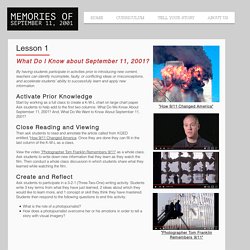
Activate Prior Knowledge Start by working as a full class to create a K-W-L chart on large chart paper. 911memories. Exploring Newspaper Front Pages By reading newspaper front pages and viewing videos, students use digital resources to gain knowledge that will prepare them for listening and interviewing people who remembered the events of September 11, 2001.
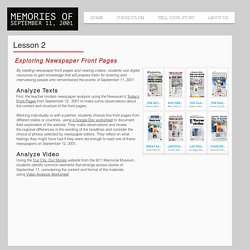
Analyze Texts First, the teacher models newspaper analysis using the Newseum’s Today’s Front Pages from September 12, 2001 to make some observations about the content and structure of the front pages. Working individually or with a partner, students choose five front pages from different states or countries, using a Google Doc worksheet to document their exploration of the website. They make observations and review the regional differences in the wording of the headlines and consider the choice of photos selected by newspaper editors. Analyze Video Using the Our City. Exploring Newspaper Front Pages Analyze Texts. 911memories. Participate in a Digital Conversation with Someone Who Remembers September 11, 2001 Students read about effective listening and questioning techniques and put these techniques into practice as they listen to memories from people who experienced September 11, 2001 and follow up with questions of their own.
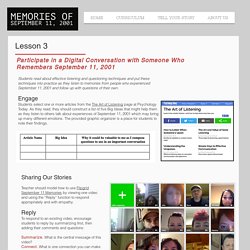
Engage Students select one or more articles from the The Art of Listening page at Psychology Today. As they read, they should construct a list of five Big Ideas that might help them as they listen to others talk about experiences of September 11, 2001 which may bring up many different emotions. United States Holocaust Memorial Museum: Propaganda Exhibit. Explore the Nazis' sophisticated propaganda campaigns and their legacy.
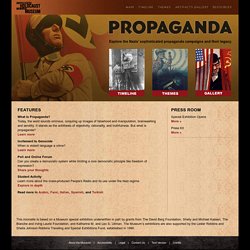
Features What Is Propaganda? Today, the word sounds ominous, conjuring up images of falsehood and manipulation, brainwashing and servility. It stands as the antithesis of objectivity, rationality, and truthfulness. K-12 & Higher Ed. Media Literacy Lesson Plans. Taking the Mystery Out of Copyright. Station 4: What's the Deal with Wikipedia? Station 6 DC3 - Station 6: You be the Judge.
Station 5: How to Use Google Scholar. Station 3: 10 Types of Plagiarism. Station 2: You be the Judge - The C.R.A.A.P. Test. Station 1: Create a Digital Notecards with NoodleTools. Exercises. Two groups of plagiarism exercises appear below, one for undergraduate students and one for graduate students.

The undergraduate exercises focus on prevention by helping students understand correct summarizing, paraphrasing, quoting, and citation. The graduate student exercise encourages a deeper understanding of how scholars use sources in their work. Both sections contain discussion questions that emphasize the kinds of situations that undergraduates or graduates are likely to encounter.
Instructors are encouraged to tailor the assignments to suit their individual needs and teaching styles. Evaluating Sources.